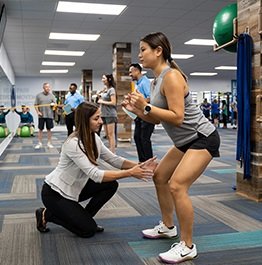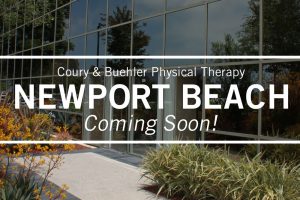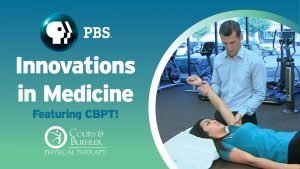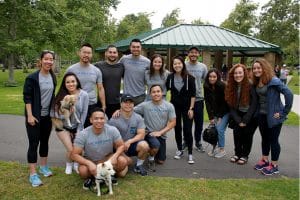
A Guide to a Rehabilitation Framework
June 17, 2021Following any injury, one of the most common questions is “when can I get back to doing my favorite activity again?”
While recovery times depend on numerous factors such as age, nature of the injury, or prior activity level, each person’s return to physical function may follow similar stages in the road to recovery.1 We will provide a guide to rehabilitation therapy, this is just one approach and break it down into five parts:
1. Tissue Healing
The first step of any rehabilitation process is to heal the affected tissues including bones, muscles, nerves, vasculature, tendons, or ligaments.
With the help of your healthcare team, a physical therapist may recommend immobilizing or unloading the joint, meaning, use a brace or cane to ease pain and pressure on the area that is experiencing pain. A Physical Therapist may also use manual therapies or prescribe simple exercises to decrease pain and swelling. This can also improve blood flow of the affected area.
2. Mobility
As body parts begin to heal, the next step is to gain and maintain range of motion.
Physical therapists use soft tissue and joint mobilizations, in addition to gentle exercises to get joints moving and the muscles looser and more flexible. Efficient body mechanics also play a role in the proper movement, which is a Physical Therapist’s specialty!
3. Muscle Initiation: Endurance, Stability, and Motor Control
As the affected area begins to reach its full range of motion, the next focus is to learn to activate and build up the muscles.
This allows those muscles to move and stabilize the joints. At this point, the goal is to increase the endurance and improve motor control of muscles. This will support improvements in range of motion to the area that is experiencing pain.
4. Performance Improvement
With performance improvement, we begin to transition into functional movements, and a rehabilitation program will feature both single joint and multi-joint exercises. Gains in strength, power, and endurance are hallmark goals in this phase to help return to activities of daily living, work, or other sports & recreational activities.
5. Advance Coordination: Agility, Skills, and Plyometrics
Advanced coordination refers to skills that may be required in high-level activities such as sports. A physical therapist may prescribe specialized, complex exercises of high intensity that simulate the demands that challenge an individual in unique environments.
The steps above are not mutually exclusive, but moving on to the next step requires the previous step to be complete. For muscle initiation, tissues must be healed; for performance improvement, mobility must be full. This is one framework physical therapists may use as a guide to rehabilitation therapy.
Where are you on the rehabilitation continuum? Schedule an appointment at CBPT to get started on a personalized rehabilitation plan.
Schedule An Appointment
Talk to our physical therapists about building your own rehabilitation framework. Contact us at 714-256-5074 to schedule an appointment or fill out the form below! A representative will contact you shortly.
In his free time, Roy enjoys reading or diving into an immersive video game. Weather permitting, he can be found outside, hiking, biking, or swimming. He was recently introduced to pickleball by his sister. If the stars align, he partakes in paintball.
Latest posts by Roy Ninonuevo II, PT, DPT (see all)
- Sprain vs Strain - October 11, 2021
- A Guide to a Rehabilitation Framework - June 17, 2021
Reader Interactions
Leave a comment Cancel reply
You must be logged in to post a comment.
SIGN UP FOR
LIFE+ is a FREE membership
that offers:
• Informative Newsletters
• Health & Wellness Tips
• Videos from Our Experts
• Special offers
…and much more!
SEARCH

GET MORE TIPS! PAIN 101 TUTORIALS
EXPLORELATEST TWEETS
ARCHIVES
- February 2025
- August 2024
- February 2024
- November 2023
- September 2023
- July 2023
- June 2023
- January 2023
- November 2022
- October 2022
- September 2022
- August 2022
- July 2022
- June 2022
- May 2022
- April 2022
- March 2022
- December 2021
- November 2021
- October 2021
- September 2021
- August 2021
- July 2021
- June 2021
- April 2021
- March 2021
- February 2021
- January 2021
- December 2020
- November 2020
- October 2020
- September 2020
- August 2020
- April 2020
- March 2020
- February 2020
- January 2020
- December 2019
- November 2019
- October 2019
- September 2019
- August 2019
- July 2019
- June 2019
- May 2019
- April 2019
- March 2019
- February 2019
- January 2019
- November 2018
- September 2018
- August 2018
- July 2018
- June 2018
- May 2018
- April 2018
- March 2018
- February 2018
- January 2018
- December 2017
- November 2017
- October 2017
- September 2017
- August 2017
- July 2017
- June 2017
- May 2017
- April 2017
- March 2017
- February 2017
- January 2017
- December 2016
- November 2016
- October 2016
- September 2016
- August 2016
- July 2016
- June 2016
- May 2016
- April 2016
- March 2016
- February 2016
- January 2016
- December 2015
- November 2015
- October 2015
- September 2015
- August 2015
- July 2015
- June 2015
- May 2015
- April 2015
- March 2015
- February 2015
- January 2015
- December 2014
- November 2014
- October 2014
- September 2014





